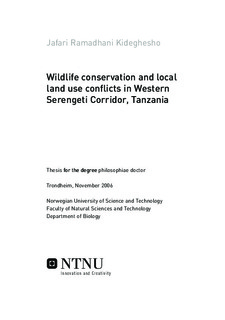| dc.contributor.author | Kideghesho, Jafari Ramadhani | nb_NO |
| dc.date.accessioned | 2014-12-19T13:11:16Z | |
| dc.date.available | 2014-12-19T13:11:16Z | |
| dc.date.created | 2008-03-05 | nb_NO |
| dc.date.issued | 2006 | nb_NO |
| dc.identifier | 123755 | nb_NO |
| dc.identifier.isbn | 82-471-8221-1 | nb_NO |
| dc.identifier.uri | http://hdl.handle.net/11250/244587 | |
| dc.description.abstract | The pre-colonial traditional societies in Western Serengeti were physically and spiritually connected to animal species and plants in their surrounding environments. This link contributed to sustainable use and harmonious coexistence. The religious affiliation and local management structures sanctioned some destructive behaviours and designated some species and habitats as sacred. Additionally, low human population and primitive technology posed low pressure on resources. Colonial regime interrupted the coexistence through introduction of new management structures. The exclusive, prohibitive and punitive actions perpetrated by colonial regime under "fences and fines" conservation approach fomented conflicts and local resentment towards conservation policies. However, despite local resentment and conflicts, the economic and political reasons forced the post-colonial government to inherit these policies uncritically.
While the idiom "Serengeti shall not die" has been a popular motto and ambition for decades, some forces had been working against it. These forces include: inefficient state-led enforcementn (due to shrinkage of government budgets in 1970s and 1980s); human population growth; rural poverty; globalisation of markets in animal products (e.g. rhino horns and ivory) and; local resentment towards the conservation policies. The reduction of the wildlife populations and habitats as a result of these forces, ruled out the efficacy of “fences and fines” approach in conserving wildlife. This prompted a need to search for alternative approach that would end this crisis.
The community conservation (CC) initiative, which emerged as a major paradigm of conservation work in late 1980s, was the most appealing option. Through provision of tangible economic benefits, CC sought to motivate local people to align their behaviours with conservation goals. This prescription was applied to Serengeti where two CC initiatives, Serengeti Regional Conservation Project (SRCP) and Community Conservation Service (CCS) were launched. Findings from this study indicate that the benefit based approaches implemented under these initiatives are fundamentally flawed, a scenario that precludes their possibility to contribute significantly to conservation objectives.
Although attitudinal survey indicated that the benefit-based strategy increase acceptability towards conservation, this may not necessarily imply a change in behaviour. Poaching was still rampant in the villages under the projects. However, even if the strategy could lead to a change of behaviour among the beneficiaries, its impact to conservation would still be insignificant since only a small fraction of the communities benefit (i.e. 14 out of 126 villages). Furthermore, even within the project villages the minimal benefits granted are inequitably distributed and monopolised by local elites. The poorest members of the society are unable to enjoy these benefits because cash is required to access them (e.g. game meat, medical services).
Along with the benefits, the results indicated that the costs inflicted by wildlife to local people and some socio-demographic factors (education, wealth) have potential role in shaping conservation attitudes. Local communities experiencing fewer costs from wildlife conservation and those most educated were less likely to support protected areas. Those with more livestock were more negative, probably because the costs of prohibition from access to water and pasture in protected areas were more obvious to them. Conservation attitudes were more positive to Serengeti National Park than to the adjacent Game Reserves, a scenario that can be attributed to history and the age of the park. It was created some 50 years when population was low and land was still available. Furthermore, the majority of the villagers were, either too young, or were not even born when the Park came to existence. Therefore, they did not feel the pain of eviction, if there was any. | nb_NO |
| dc.language | eng | nb_NO |
| dc.publisher | Fakultet for naturvitenskap og teknologi | nb_NO |
| dc.relation.ispartofseries | Doktoravhandlinger ved NTNU, 1503-8181; 2006:221 | nb_NO |
| dc.relation.haspart | Kideghesho, JR. Co-existence between the pre-colonial traditional societies and wildlife in western Serengeti, Tanzania. . | nb_NO |
| dc.relation.haspart | Kideghesho, JR. The environmental history and political ecology of wildlife conservation in Western Serengeti Corridor, Tanzania. . | nb_NO |
| dc.relation.haspart | Kideghesho, JR; Røskaft, E; Kaltenborn, BP; Mokiti, TMCT. "'Serengeti shall not die". The International Journal of Biodiversity Science and Management. 1(3): 150-166, 2005. | nb_NO |
| dc.relation.haspart | Kideghesho, JR; Røskaft, E; Kaltenborn, BP. Factors influencing conservation attitudes of local people in Western Serengeti, Tanzania. Biodiversity and Conservation. 16(7): 2213-2230, 2007. | nb_NO |
| dc.title | Wildlife conservation and local land use conflicts in Western Serengeti, Tanzania | nb_NO |
| dc.type | Doctoral thesis | nb_NO |
| dc.contributor.department | Norges teknisk-naturvitenskapelige universitet, Fakultet for naturvitenskap og teknologi, Institutt for biologi | nb_NO |
| dc.description.degree | PhD i biologi | nb_NO |
| dc.description.degree | PhD in Biology | en_GB |
